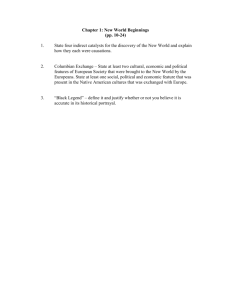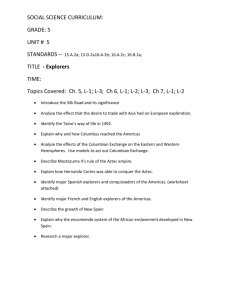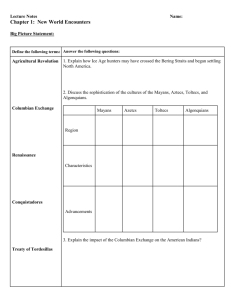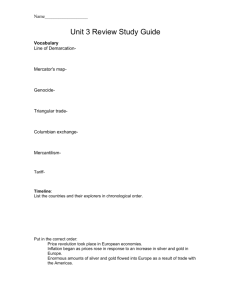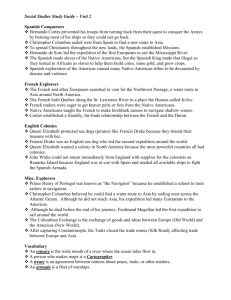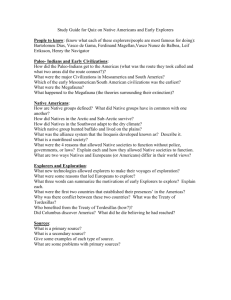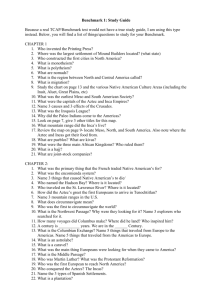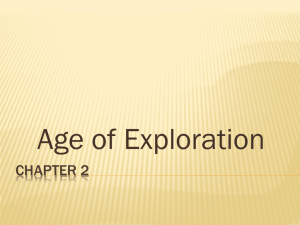Cpt 2 Notes - North Mac Schools
advertisement
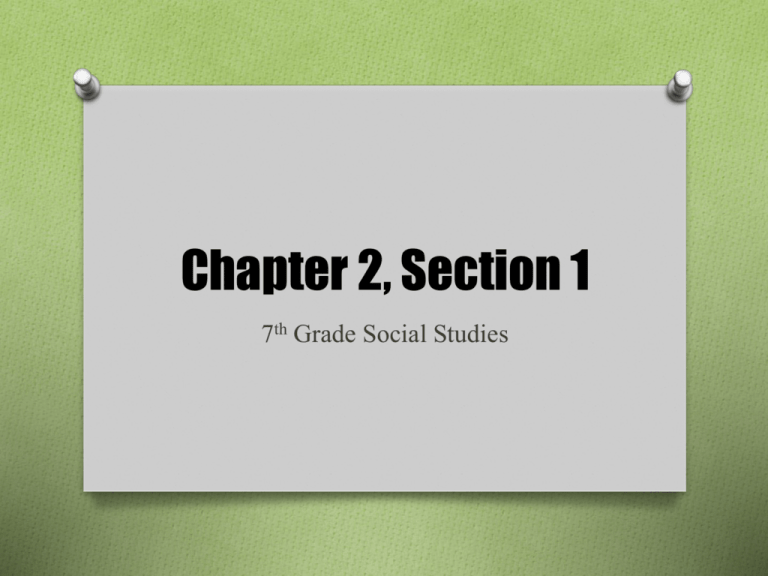
Chapter 2, Section 1 7th Grade Social Studies Starter Activity Starter Activity: How has technology changed over the years? List as many examples as you can think of in your notebook. Be prepared to share in class. Key Vocab & Ideas O classical = relating to Ancient Greece & Rome O technology = the use of science in commerce and industry O astrolabe = an instrument used by sailors to observe O O O O O positions of the stars pilgrimage = journey to a holy place mosque = Muslim house of worship Quran = Muslim holy book acquire = to come to have something impose = to establish or imply by authority Crusades O Started in 1095. Time period called "The Middle Ages" O O O O O ****watch Brainpop on Middle Ages*** 9 trips total/lasted about 200 years Led by European Christians Goal = regain control of their holy sites from the Muslim Effect = brought Europeans into contact with Middle East Crusades O Europeans bought spices, sugar, silk, and other items from traders in the Middle East. O The items were sent back home to major cities like Venice, Genoa, and Pisa. O Interest grew. People wanted these new, exotic items. O Problem: Middle Eastern traders charged high prices on their goods. O Solution: Europeans began to look at other trade routes & places to buy goods. Renaissance O Renaissance: "rebirth" O *The expansion of travel and sampling new goods caused O O O O O Europeans to want to improve their knowledge of the world. *Began studying Ancient Greek & Roman (classical) philosophies *New experimental approach to science *Began thinking about the universe & writing about their ideas. *Studied sculptures & architecture of classical world. Visit this website: http://www.kidsdiscover.com/spotlight/renaissance-forkids/ In-Class Project (omit 2015) Exploration O *Nation-states began to form in Europe. O *Monarchs came into power. O *Leaders wanted to increase trade and make their countries stronger. O Marco Polo: Famous explorer/trader who wrote about his travels. O "The length of this Desert is so great that 'tis said it would O take a year and more to ride from one end of it to the other. O And here, where its breadth is least (narrowest), it takes a O month to cross it. 'Tis all composed of hills and valleys of sand, O and not a thing to eat is to be found on it." O ---------from The Travels Of Marco Polo (talking about the Gobi desert) Extension Activity O Common Core Aligned: The Road With Two- Humped Camels Inventions O Advances in technology (use of scientific knowledge for practical purposes) O Allowed more and more European voyages for exploration and trade. 1. printing press was invented 2. better maps 3. better ships (now had rudder and triangular sail = steer into the wind) 4. gained better instruments: *astrolabe=measured the position of the stars *compass = determine direction African Kingdoms Flourished from 400-1600 AD Extension Activity Extension Activity: Please answer the following question in your notebook. What events and technological advances paved the way for European exploration? Use your notes & textbook to help you. Chapter 2: Section 2 Early Exploration Starter Activity In your notebook, answer the following question: Would you have wanted to be an early explorer? Explain why or why not. Key Vocab & Ideas O saga = long, detailed story O line of demarcation = imaginary line running down the middle of the Atlantic Ocean from the North Pole to the South Pole dividing the Americas between Spain and Portugal O strait = narrow passageway connecting two larger bodies of water O circumnavigate = sail around the world Cause & Effect Of Early European Unaware of the Americas. Assumed only one large land Exploration mass. Maps didn't include the Americas. Cause Effect O European desire for new O Knowledge grows about trade routes O growing power and wealth of European nations O competition for trade O missionaries' desire to convert people to Christianity other regions O Europeans and Native Americans clash O Enslavement of Africans O Rivalry in the Americas grow Famous Early Explorers Henry The Navigator (Prince Of Portugual) O 1420 set up Sarges ("school of navigation") O planned voyages & analyzed reports O did not go on any expeditions himself Bartholomeu Diaz O mission (from King John of Portugal) was to reach Asia O had only 2 caravels and a supply ship O sailed south around the tip of Africa O forced off route by storm & returned home O discovered the southern tip of Africa (Cape Of Good Hope) O Caravel - travel in the shallows, lateen sail caught the wind, 75-90 feet long Vasco Da Gama O first Portuguese to land in India O July 1497, set out with 4 ships O sailed around the Cape Of Good Hope and up the East coast of Africa O made many stops on the eastern coast O landed in Calicut, India in May of 1498 Amerigo Vespucci O 1502 sailed along the coast of South America O said it wasn't part of Asia, continent by itself O geographers called it "America" Ferdinand Magellan O sailed around the tip of South America through a strait (narrow water channel) O named the ocean Pacific (pacifico means peacefully in Spanish) O crew sailed all the way to Spain in 1522 = O first to circumnavigate (travel around) the world Extension Activity Why did Spain and Portugal want to find a sea route to Asia? Think of as many reasons as possible. Use your text book to help you. Who should get credit for discovering America? The Vikings or Columbus? You decide . . . Round 1: The Vikings O First Europeans to sail to North America O Visited Iceland & Greenland in the 800s and 900s. O Made settlements (remains have been found by archaeologists in Newfoundland O sagas (traditional stories) tell all about Leif Eriksson. Explored a land west of Greenland around 1000 AD. He called it Vinland. O ******watch Brainpop on Vikings****** Round 2: Christopher Columbus O 1492 O Sailed with 3 ships: Nina, Pinta, and Santa Maria O Thought he was at the East Indies, but actually was in the Caribbean Islands O named the place San Salvador O made 3 more voyages: explored & mapped the coasts of Central & northern South America O ******Watch Columbus on Brainpop****** Discussion Time! O Who do you think should get credit for “Discovering” America? O Be able to support your answer. Extension Activity O Common Core Aligned: What Stopped Columbus? In-Class Project Select either Cortes and the Aztec (p. 43) or Pizarro and the Inca (p. 44). 2) Fold the top side of paper to bottom to divide it in half. 3) On the bottom half, draw and color a map of the area. Use p. 12, 14, and 44 for reference. 4) Draw a line to divide the top half into 3 columns. IN EACH COLUMN: *******Write the name of one important concept (idea, invention, person, religion, etc. ) *******Draw and color a picture representing the concept. *******Write 3 sentences providing facts about the concept. 5) Cut out the outline of a human (the explorer in the area). Draw, color, add construction paper, etc. to decorate your human. Add armor, etc. 6) Tape/glue to map. 1) Project Example Chapter 2: Section 3 Spain In America Starter Activity Read this quote: "I know in my heart that we shall TAKE vast and wealthy lands, peoples such as have never before seen . . . If you do not abandon me, as I shall not abandon you, I shall make you in a very short time the richest of all men who have crossed the seas." -----from Cortes: The Life Of The Conqueror by His Secretary Why do you think explorers felt it was "OK" to take from the native people? Do you feel the same way? Explain. Write your thoughts in your notebook. Key Vocab & Ideas O conquistador = Spanish explorers in America in the 1500s O encomienda = system of rewarding conquistadors with tracts of land and the right to tax and demand labor from Native Americans who lived on the land O pueblo = home or community of homes built by Native Americans O plantation = a large estate run by an owner or manager and farmed by laborers who lived there Spanish Conquistadors In The Americas (watch brainpop) Mercantilism = Economic Rivalry What fueled the competition? $$$ from fishing and fur trading American land and resources Competing for power at home in Europe Hernan Cortes O Landed in Mexico in 1519 O O O O with 500 soldiers made alliances with the Aztec people's enemies went Tenochtitlan (Aztec's main city) & was welcomed took Montezuma (Aztec ruler) prisoner Aztec rebelled in 1520 and Montezuma was killed Francisco Pizarro O 1523 captured Inca ruler and destroyed most of the Inca military O They captured the Inca ruler (Atahualpa) and falsely accused him of crimes. Executed him. O Inca were unable to fight/regroup without their leader. O Pizarro gained control over the whole empire Juan Ponce De Leon O Hoped to find gold and the "Fountain Of Youth" O "a spring of running water of such marvelous virtue that drinking it makes old men young again" Robert La Salle O French O Wanted to reach the Gulf of Mexico by traveling down the Mississippi River O Results O Reached the Gulf of Mexico and claimed the entire Mississippi River Valley for France Looking For The Seven Cities Of Cibola Francisco Hernando De Soto Vasquez De Coronado Sir Walter Raleigh O English O Sent by Queen Elizabeth to claim land for England in North America O Results O Claimed land from present-day North Carolina to Maine and named it Virginia, in honor of Queen Elizabeth. O Sent 100 people to settle at Roanoke Island off North Carolina, but colony disappeared by 1591. Why Spain Succeeded O Weapons = used guns & cannons vs native weapons of sticks & stones O Animals = had horses to travel quickly O Other natives in the area were tired of being treated hatefully by the Aztec and Inca = decided to help the Spanish O Disease = Native Americans didn't have immunity to European Illnesses. Smallpox was one of the most deadly diseases at that time. Spanish Law Called For 3 Kinds Of Settlements In The Americas: O Pueblos: towns O Missions: religious communities O Presidios: military fort Social Classes Formed Peninsulares = born in Spain, owned land, served the church & ran the government Creoles = born in America to Spanish parents Mestizo = people who have a Spanish and Native American parent Native Americans = born in America, lived in great poverty African slaves = only class below Native Americans. No freedom. No money. Considered property. Encomienda System O right to demand taxes or labor from Native Americans living on the land O turned Native Americans into slaves O many Native Americans died from malnutrition and disease O Spain passed New Laws in 1542 = forbade anyone from making Native Americans slaves Plantation System O Allowed Spanish settlers to make large profits = exporting tobacco, sugarcane, and other crops. O Since Native Americans were no longer allowed to be slaves, they brought people from Africa and made them slaves to work on the farms. Extension Activity How did Spain's conquests affect the economic and social development of the Americas? Chapter 2: Section 4 Starter Activity What would you do if someone tried to force their beliefs on you? Write about it in your notebook. Key Vocab & Ideas O mercantilism = theory that a state's or nation's power depends on its wealth O Columbian exchange = exchange of goods, ideas, and people between Europe and the Americas O Northwest passage = water route to Asia through North America sought by European explorers Reasons Europeans Continued To Move To Americas: Religion: O Catholics (Spanish & French) worked to spread their faith to America O Protestants (Dutch & English) created settlements to work in peace (learn more about that in the next chapter) O *Mercantilism = idea that a nation's power is based on its wealth O ---encouraged people to move to North America $$$$ in natural resources (gold, sugar cane, tobacco, salt) O ---increased the rivalry between European nations Columbian Exchange O Two halves of the world brought together for the first time O Occurred because of the contact between the European Explorers and Native Americans. O Period of cultural and biological exchanges between the New and Old Worlds. O Exchanges of plants, animals, diseases and technology O *******watch Brainpop on it***** Positive Impacts From The Columbian Exchange O From Old World to New: Cattle were brought to Mexico in 1521. Source of food, can pull heavy loads. Horses allowed hunters to travel larger distances. O From Old World to New: The Spanish brought sugar to Mexico. O From Old World to New: Bananas were first grown in Southeast Asia and brought by Europeans to the Caribbean Islands. Positive Impacts From The Columbian Exchange O From New World to Old: Corn can be grown on land that can't easily grow rice or wheat. Has become an important food in Europe, Egypt, India, China, etc. O From New World to Old: Potatoes have become an important source of nutrition for many countries all over the world. Negative Impacts From The Columbian Exchange: From New World To Old World O Sand fleas, or chiggers, are insects that dig under human skin to lay eggs. Negative Impacts From The Columbian Exchange: From Old World To New World O Because they were separated from the rest of the world, Native Americans had no prior immunity to smallpox and other deadly diseases. O European animals brought diseases with them that attacked llamas and alpacas. Negative Impacts From The Columbian Exchange: From Old World To New World O Rats hitched rides on ships carrying Europeans. They spread all over the Americas quickly. O Many explorers wanted to find gold and silver in the New World. They used natives as slaves. When the natives began to die out, they turned to Africans as free labor. Columbian Exchange Simulation You will randomly receive a food card. The card will contain a modern recipe created with foods available as a direct result of the Columbian Exchange. If your food's primary ingredient is from the "New World", there will be a number in the bottom right-hand corner. If your food's primary ingredient is from the "Old World", there will be a letter in the bottom right-hand corner. Please note, there are some recipes which contain ingredients from both worlds, but I based classification on the primary ingredient. For example, baby-back ribs are considered an Old World food in this simulation because the primary ingredient, pork, is an Old World food. Columbian Exchange Simulation O Step 2: You will be allowed 5 minutes to look at everyone else's cards. You are allowed to trade, should you choose to do so. HOWEVER, for this step, you are only allowed to trade within your group. In other words, "New World" foods (those marked with a number) are ONLY allowed to trade with each other. "Old World" foods (those marked with a letter) are only allowed to trade with each other. O After I call time, head back to your seats. Share. Do you feel you had a good trading experience? Explain. Columbian Exchange Simulation O Step 3: Now you will have 5 minutes to trade again. This time, you may trade for any recipe ~ Old or New World. You do not have to trade if you like your recipe. O When I call time, return to your seats. How do you feel the trade went this time? Was your experience positive or negative? Explain. Columbian Exchange Simulation O OH NO!!!!! By interacting with each other, you have shared your germs! Gross! Some of the New World consumers have been exposed to the small pox, for which they have no builtup immunity. (Old World consumers have been exposed to this disease previously and have developed immunity.) Flip your card over. If you have an X, you have become very ill and shall perish. You are out of the game. Extension Activity Evaluate our simulation. How did you do? Did you like your food? Describe your trades. Have a positive or negative trading experience? How does this relate to the real Columbian Exchange? Write a paragraph to share your thoughts. Draw a picture to illustrate your thoughts. Searching For The Northwest Passage O European countries wanted to trade with Asia. O Water travel was faster than land travel. O It took too long to sail around the tip of Africa or South America. O Europeans needed a western route to Asia that cut through North America Northwest Passage Why were Europeans interested in Asia? • What were explorers searching for in their exploration of North America’s coast? • Why were explorers searching for this? • Northwest Passage Why were Europeans interested in Asia? • TRADE What were explorers searching for in their exploration of North America’s coast? • Why were explorers searching for this? • Northwest Passage Why were Europeans interested in Asia? • TRADE What were explorers searching for in their exploration of North America’s coast? • A NORTHWEST PASSAGE Why were explorers searching for this? • Northwest Passage Why were Europeans interested in Asia? • TRADE What were explorers searching for in their exploration of North America’s coast? • A NORTHWEST PASSAGE Why were explorers searching for this? • EUROPEAN NATIONS WANTED A QUICKER TRADE ROUTE TO ASIA Northwest Passage O Direct water route to Asia through The Americas O John Cabot attempted to find it in 1497. Landed in Newfoundland. O Jacques Cartier looked for it in 1535. Sailed up the St. Lawrence River. Reached what is now Montreal, Canada. Northwest Passage O Henry Hudson 1. 1609 discovered Hudson River (in Albany, NY now) 2. 1610 found Hudson Bay 3. thought he was in the Pacific so he searched for a way out 4. crew rebelled & sent Hudson off of the main ship in a small boat-never to be seen again. French Trading Posts O French uninterested in permanent settlement of North America O Only wanted resources for trade (fish, animal fur) O Quebec and other areas of Canada Dutch Settlements O Dutch East India Company settled in the North East (now Albany, NY) on the Hudson River O Built Fort Nassau (near Philadelphia, PA) O New Amsterdam, located on the tip of Manhattan Island (paid the Manhates people 60 Dutch guilders (about $24) in goods like cloth, axes, and hoes. Now = New York City Extension Activity Why did European nations establish colonies in North America? Think of as many reasons as possible. Do you feel these reasons were valid? Yes or No. Copy this chart into your notebook. Complete. Reasons Europeans Moved To NA Reason: Valid: Research Project 1) Choose an explorer that we have discussed in this chapter. 2) Use at least 2 other resources to find out more information about your group. Fill out the RESOURCE PAGE (p. 2). 3) Answer the following questions: Where did he live? Tell about his family. What was the goal of his journey? Where did he explore? Did he have a successful mission? How can you tell? What can we learn from your explorer that applies to today? Tell at least 1 interesting fact (other than listed above) about your explorer. 4) Present your information to the rest of the class. You will need a visual display AND share orally.
